Note: I was provided a complimentary copy of Viticulture (Essential Edition) for the purpose of review. The thoughts and opinions in this review are my own.
At a Glance: Viticulture
Year Published: 2015
Designers: Jamey Stegmaier, Alan Stone
Publisher: Stonemaier Games
Artists: Jacqui Davis, David Montgomery, Beth Sobel
Player Count: 1-6
Editor: N/A
Suggested Age: 13+
Playing Time: 45-90 minutes
Theme: Farming, food & drink, economic
Mechanisms: Worker placement, contracts, solo
Find more about Viticulture by visiting Stonemaier Games online on Facebook, Instagram, and their website!
“It had given Dalinar access, again, to the necessities of life. Like wine.” ― Brandon Sanderson, Oathbringer
Viticulture Intro Story: Field of Dreams
The guests were coming, and Alan was fresh out of wine. Normally, that wouldn’t be a problem. However, being that he owned and operated a vineyard, not having wine for tours was going to be a big problem.
There wasn’t time to prepare. The grapes still needed to ripen, and the cellar needed to be filled. Not to mention the buildings around the vineyard were falling apart. Alan sighed. This was it. This was the end of his career in wine making.
At noon, the guests arrived—right on schedule. They were an older, wealthy couple with their two sons and their spouses. Rumor had it the family as a whole was looking for the next big vineyard to invest in. Alan squared his shoulders and met his guests as their carriage stopped at the top of the path near his home.
“Welcome!” Alan said as they carefully filed out of the carriage. “You must be the Ricci family! It is an honor to host you this day!”
Mr. Ricci—the oldest Mr. Ricci—sniffed the air as something was putrid. “Indeed,” he muttered. “Shall we be off, then?”
“Uh, yes. Yes! Of course. Right this way.” Alan led the group to their first stop, the place where he always started—the fields.
It was a short walk from the cottage to the fields, but the sun’s heat took its toll. The Riccis were all dabbing at their foreheads, sweat threatening to drip down at any moment. Alan was used to the heat, but he didn’t want to appear too much a slob—his vineyard was bad enough already—so he dabbed at his forehead as well.
When they arrived at the fields, the oldest Ricci boy looked around in confusion. “Where are the vines?”
Alan smiled, although he wasn’t feeling cheerful in the least. This is it, he thought. The beginning of the end. Still, he went on with it. “Ah, yes. This is the field of dreams. It is where all my best grapes grow.” His guests seemed even more confused. Now Alan was really beginning to sweat, and this time it wasn’t from the heat. “You see, this land is far too useless to grow anything of worth. In fact, the land is so horrible, that I’m afraid I won’t be growing anything on it for generations!”
“So…” Mrs. Ricci—the oldest Mrs. Ricci—said, “you don’t actually have a vineyard?”
“Oh!” Alan laughed in bitter irony. “You wanted to see a vineyard! And wine, too, I suppose? Not me whining at all! Wrong type of wine?” The group nodded, and an idea struck his mind. “Well, I’m afraid you are a week too late. You see, the very day before your announcement arrived, stating that you would be visiting—and that you would not take ‘no’ for an answer—I sold all my grapes and wine to a wealthy baron who was passing through this way on business. After his tour and wine tasting, he said he had never tasted such exquisite wine in all his life. Which, I might add, seemed like he had lived a lot of life, if you catch my meaning. But he didn’t want just what I had in the cellar. Oh no! He wanted it all—the grapes ready for the crush pad, the wine, and even the vines! It was the sale of a lifetime, you understand, which I’m sure you do, being folk of such high regard as yourselves. And so I lament the fact that I have nothing for you to see. The baron said he would be back next year as well, to buy out my next harvest of grapes. And figs. He likes figs.”
Alan coughed, not sure how his charade was going over. After an eternity of silence, Mrs. Ricci—the youngest Mr. Ricci—rolled her eyes. “I see we’ll just have to buy your land, then. Will one-hundred thousand lira suffice?”
Alan’s jaw dropped. “Umm…”
Mr. Ricci—the spouse of the youngest Mrs. Ricci—cut Alan off. “Apologies, Mr., uh…”
“Bianchi,” Alan said.
“Right, of course. Mr. Bianchi, we do not mean to insult you or your prestigious vineyard. We have two-hundred thousand lira for you today for all of your property, buildings, and everything therein. Is this a fair offer?”
Alan stood in silence, shocked.
“Please say you accept,” Mr. Ricci—the oldest Mr. Ricci—said.
Alan pulled himself together and nodded. “I seem to have no choice,” he said. “I accept. When would you like me out?”
“How about immediately?” Mrs. Ricci—the oldest Mrs. Ricci—said.
“Done,” Alan said. He then went into his cottage, quickly packed his few belongings and a few changes of clothing, and was off the property as quickly as possible with 200,000 lira in his pocket. His first item of business would be to find a safe depository for his newfound wealth. Before that, however, he needed to get as far away from his “field of dreams” as he could, before the new owners discovered the infestation of grapeleaf skelotonizers and other nefarious insects that kept his vines from growing these many years.
When he reached the nearest bank, the banker wouldn’t take his 200,000 lira. “It’s counterfeit,” the man said. “Fake.”
Fake. There was only one thing Alan could do, and it wasn’t cry, and it wasn’t run back and demand his property be returned. Instead, he laughed. He rolled on the floor laughing and laughing, until finally he was taken away to an institution where he laughed all day, every day, until the end of his life.
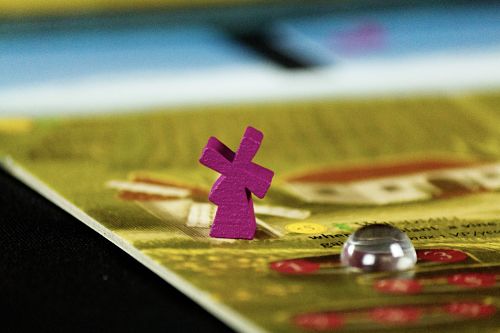
Overview/Roadmap
This review has two parts. First, there is the Short Review, where various aspects of the game are discussed. Then comes the Gameplay Review, in which the setup and gameplay are discussed in detail, along with initial thoughts. Following the Gameplay Review section are some final thoughts and a final verdict of the game. Feel free to jump around, or read it all in one go.
Viticulture Short Review
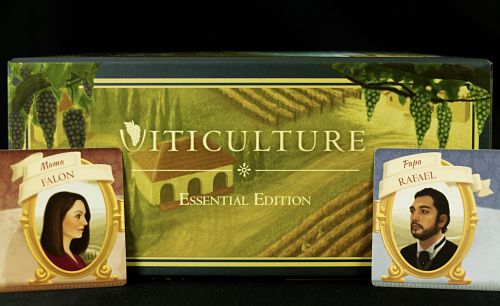
Viticulture is a worker-placement game where players manage income, build buildings, plant fields, make and sell wine, and complete contracts to earn points. Points can be used as resources in order to do other things. The player order is determined by a form of bidding mechanism, where the later your turn is, the better your reward. The solo variant is smooth and the game also plays well at all player counts.
Immersion
I’m not a wine drinker—in fact, I don’t drink any alcohol of any kind, due to religious beliefs—so I wondered how I would receive Viticulture once I finally got to play it. Well, I can’t relate to the excitement of wine, but I can relate to the game. I was always looking to see what I needed to do next: build a building, plant a field, harvest a field, and the like. I drew cards hoping for good visitors and orders I could fulfill. In all, I really was immersed in the gameplay, even if I know nothing about wine. The way the game plays makes you think like you really are running a vineyard, and the immersion factor really did work for me.
Theme
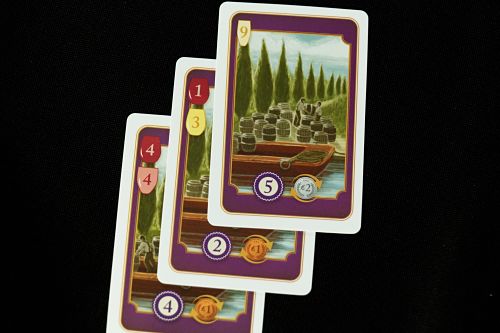
The theme of making and selling wine never caught my attention. Some folks are wine aficionados, and would therefore be drawn in by the theme. For me, it was the mechanisms that sold this one for me. If you’ve been reading my reviews, then you’re likely aware that I am a huge proponent for a good theme. Now, I’m not saying that Viticulture’s theme isn’t good, but rather it’s just not for me. Despite that, the game plays really well, and that is what’s important. And, despite the theme not drawing me in initially, I really enjoyed the setting and visuals in the world of Viticulture, which definitely did add to the experience.
Art & Components
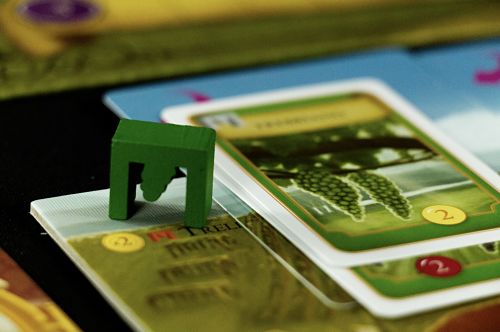
The art is perfect for the theme, with its rustic setting and feel. It’s actually grown on me quite a bit as I’ve played.
The components consist of cards, cardboard coins, glass tokens, and various wooden tokens (meeples, structures, etc.). It’s your basic board game components, and all is well with them.
Standout Performances
- Solid worker-placement mechanism
- This Essential Edition includes some of the expansions from the Tuscany box
- Engaging solo variant
- Balanced at all player counts
- Great marriage of theme and mechanisms
Breaking the 4th Wall
In theater, breaking the fourth wall refers to when characters (or something else) directly address the audience, thus pulling them out of the narrative and making the astutely aware that they are, in fact, watching a performance and that’s it’s not actually real.
For me, the only thing that really didn’t work for me was the theme. But, as I got playing, the gameplay took over and the theme was far less important. And now I don’t even mind it! But that is all personal opinion, so what’s great for me might fall flat for others, and vice versa.
Gameplay Review
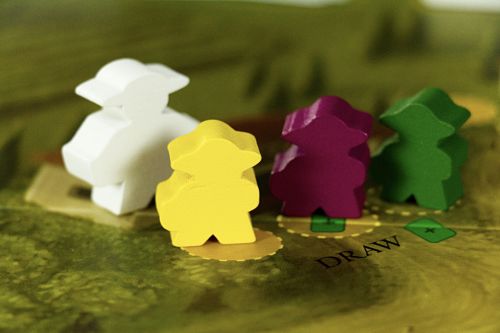
First Impressions
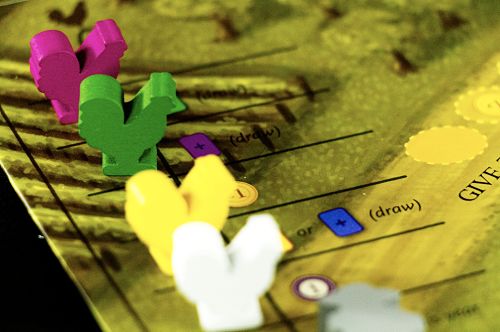
I’ve seen Viticulture around for a long time (long time); since it came out, really, although I was still fairly new to the hobby then myself. However, the wine theme (as I mentioned above), didn’t speak to me. The first time I played was only a month prior to the publishing of this review at five players.
I liked it.
There’s something to be said about a game that takes someone’s apathy toward it and makes them do a near 180 in their perspective after playing just one time. So my first impressions of the game, then, were nothing but good things. And—spoilers—my opinion of Viticulture only improved as I played it more.
Setup
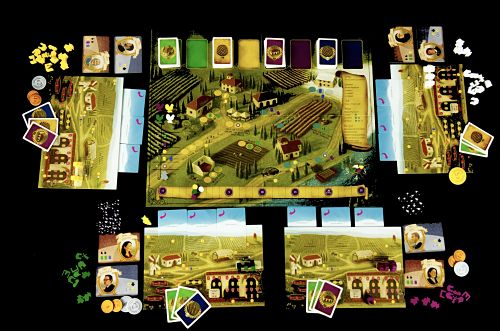
Setup doesn’t take a lot of time. Everyone gets a vineyard mat and three field cards, each of different values. Then they take their color of wooden workers and other tokens, a Mama and a Papa card, and place their scoring token on the score track (at zero; you can lose points and go negative). Your wine token goes on the Residual Payment track, and your rooster goes above the wake-up (i.e. player) order chart. Shuffle the four decks of cards and place them in their specific spot on the board. Players start with two regular workers and one grande worker. The resources you start with are indicated on your Mama and Papa (red and blue) cards.
And that’s really all you do for setup. Despite a lot of spaces on the boards, cards to be shuffled, and various tokens, there isn’t much. And I like that about Viticulture; it’s not a pain to get set up, and putting everything aways is simple as well. *chef’s kiss*
Gameplay
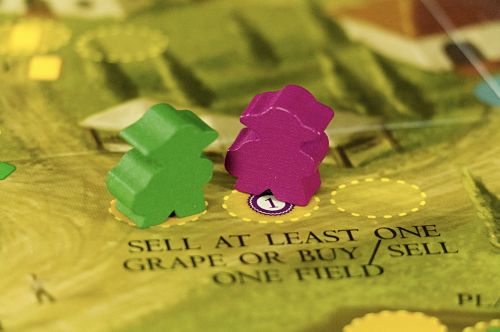
As with most (all?) worker-placement games, players take turns placing one of their workers on an available worker space. Throughout the game, players buy more workers (to get more actions each round), plant and harvest grapes, build structures (to be able to plant grapes with a greater yield), and more. The main goal is to get points, and most points come from fulfilling orders on order cards. To do this, players must plant grapes, harvest their grapes, turn their grapes into wine, let the wine age until it’s ready for the order, and then make it to the worker spot where you can sell the order. Sounds simple enough, but each worker can only be placed once each round, so if you use all of your workers during the Spring phase, you won’t have any workers left in the Winter stage (and that’s where you fulfill contracts and do other juicy actions). Once a player hits 20 points on the score track, the game ends at the end of the current year (i.e. round).
Thoughts on Gameplay
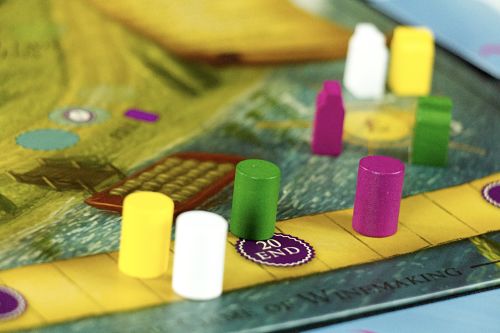
The gameplay is nothing short of wonderful. I found that the worker spots were easy to understand, the card text were pretty easy to understand (there were a few I scratched my head over, but I think I was reading too much into them), and the symbols all made sense. I found it intuitive and simple to learn. While it wasn’t difficult to learn, I felt that the choices were robust and there was a lot to think about.
Solo Play
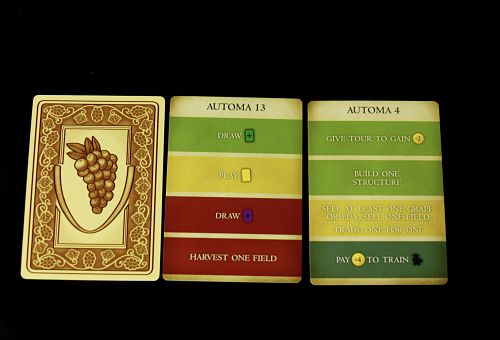
The solo variant is, as is customary with Stonemaier products, wonderful. It’s a bit different than a regular game in that you only have as many rounds as there are wakeup positions (in other words, you have seven rounds). To track this, you place a glass token on each of the wakeup spots and take it off when you place your rooster there. It’s an interesting way to do it, and, quite frankly, very satisfying.
The Automa uses a deck of cards to show where it will park its workers, thus taking up valuable spots seemingly at random (alright, it’s totally random due to card draw). The Automa deck works nicely and really does simulate a second player. So, if you have a yearning to play Viticulture but don’t have anyone to play with, the solo variant will sate your appetite.
Viticulture Final Thoughts
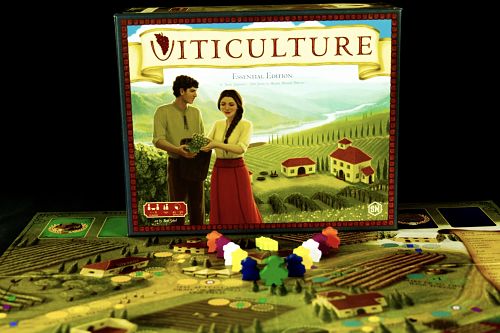
Viticulture wasn’t too high on my list of games I wanted to play, but once I played it, I loved it. The worker-placement aspect is solid, the cards provide additional intrigue and strategy, and the way you manage your grapes and wine create a unique feel of progression.
Final Verdict: Viticulture
Viticulture is solid. I’m in it from beginning to end, and I enjoy it throughout. As far as worker placement games go, I still prefer Champions of Midgard, but Viticulture is certainly up there among those evergreen games. At the end of it all, Viticulture receives TwoCaptivating Thumbs from me. It’s easy to see why Viticulture is held with such high regard among so many, and I can’t see myself turning down an opportunity to play—ever.
Like This, Like That
Obviously, if you’re a fan of worker placement games, you will most likely love Viticulture. Also, if dice aren’t your thing (i.e. Stone Age and Champions of Midgard), Viticulture provides an engaging and satisfying experience without dice—just cards (which all seem to be very well balanced). Or if you’re just into the farming and/or wine themes, then this is bound to quench your thirst.

Verdict Scale (Lowest to Highest)
The Final Verdict is based on a scale of 1-7, although this scale is not numbered. Instead, it uses thematically appropriate words to describe the performance of the game.
Tomatoes – This game was emotionally taxing and difficult to finish.
Uninspiring – This game had me daydreaming about other games.
Lackluster – This game had its moments, but it probably won’t see much table time.
Laodicean – This game is decent. It works. There’s a reason people like it.
Two Thumbs Up – This game is pretty dang good.
Captivating – This game is outstanding! It’s more than good; it’s practically a staple.
Standing Ovation – This is the best game you will ever play. Period.
Read short fiction inspired by board games at BGI’s stories page!
Visit Stonemaier Games on Facebook, Instagram, Twitter, and at their website.



